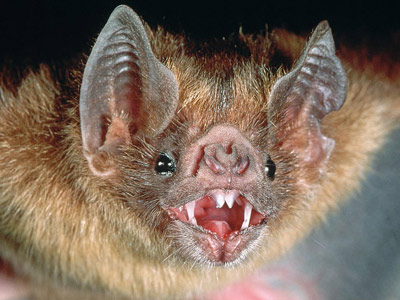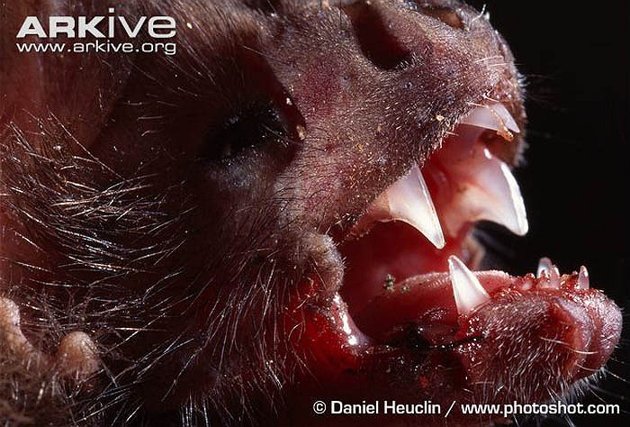The world of blood-sucking species
The sun snapped the last rays of the day into a tropical forest. The cows and horses on a nearby farm began to doze off and this was the time when thousands of vampire bats flew out of the cave to find their targets.
The most gruesome "demons" on the planet
Vampire bat
People in areas with hot and humid tropical climates in Central America and South America are no stranger to vampire bats. It was not a descendant of Count Dracula , but blood-sucking bats . They are smaller than a mouse, but possess extremely sharp teeth.

A blood-sucking bat in Central America.(Photo: National Geograohic)
Bats shave animal hair with teeth, revealing a small patch of skin. They create a small bite on the skin and a drop of blood appears. Bats take about 2 tablespoons of blood in one suction. During the process, animals often sleep and never know that it is becoming a bat's party.
For humans, sucking blood to live is a bizarre phenomenon. But vampire bats are not the only animals that exist because of blood. Although blood sucking is a disgusting and dangerous behavior, blood is a rich and easy-to-find liquid. That explains why many animals choose blood as food. They live everywhere, even near you.

Leech
Vampire bats live only in tropical regions, and leeches are everywhere. Fresh water leeches have a deep body shape with two mouths on the body. Each mouth is a large power straw, allowing leeches to stick to the target. Leeches often attack fish and reptile animals. If they meet people, they will not be bored.

Diapers use sharp teeth or needle-shaped tubes to pierce skin before sucking blood. They can store a few times the amount of body mass. When full, leech leaves the prey.
A leech bulging by blood is a scary image. However, they are not purely harmful animals. The doctor best understands the benefits of leeches. Sometimes we see them put on leeches on patients' skin to stop bleeding.
Leech has the ability to create a chemical that helps prevent blood clotting. Scientists are studying this chemical in hopes of using it to treat heart disease. If they succeed, hundreds of millions of people on Earth will be grateful to the leeches and don't expect them to become extinct anymore.
Bed bugs, ticks and ticks
Some blood-sucking insects - like aphids and fleas - can appear in your home. With their tiny size, they can hide everywhere without being detected. Most people suck blood, but not all. They can enter your home by clinging to insects or pets. Their bite is not dangerous, but itching.
Bed bugs like warm, pleasant places like a bed mattress. When mites crawling out in the middle of the night to make a living, surely a hot body has been lying on the mattress ever since and is falling asleep. Like leeches, bed bugs can store a much larger amount of blood than their body weight. Their bite makes the skin swell slightly because of itching, but they don't spread disease.

Fairy often lurks in low foliage, bushes or tall grass.(Photo: bioweb.edu)
Those who go to the forest or climb the mountain do not like the fairy . As a spider animal, it lives in wooded areas. They hide in low foliage or high grass. Earn no ability to jump or fly. They only know crawling and are good at waiting for their prey.
Calculus can wait for their meals for days, even years. When an animal or person passes by, they cling and start working.It took a few days to suck up blood and the prey did not know their presence on the body.
A tiny fairy can become a great threat, because they spread some diseases to the prey. Therefore, when picnic in the forest or climbing mountains, you should avoid bushes or tall grass. You should also wear stockings and check clothes after the trip ends.
Female mosquito
You may not know the tick, but everyone knows mosquitoes. We often think of blood-sucking behavior when seeing mosquitoes, but in fact their main food is fruit and nectar . For most of life, mosquitoes are just around flowers and plants like other harmless butterflies.
Only when the mating mosquitoes are everything is different. They turn into a bloodthirsty person. But they don't suck blood for themselves. Instead, blood is reserved for the next generation of mosquitoes, because the liquid provides the necessary protein for mosquito eggs.

Mosquito taps have 6 small needle-shaped ends to pierce the skin. Some mosquitoes have many saw blade edges. They help mosquitoes create larger cuts. Blood flows into a long tube in the mosquito hose, and at the same time secretes saliva through another tube. A chemical in saliva makes the cut on the skin unable to close.
People think of ways to fight mosquitoes, such as getting a mosquito net, wearing long clothes when they go out. Dawn and sunset are two times when mosquitoes are most active. When you hear the whirring sound in your ears, you should be ready to raise your hand to beat them.
For humans, mosquitoes are really unpleasant creatures. They can spread disease from one person to another.West Nile malaria and virus are just two of the diseases that mosquitoes can cause. Not long ago malaria was the most deadly disease in the United States. In Africa and many other regions, malaria is still a common disease. It kills at least one million people every year.
And many other species

Two gold-billed birds feed on the back of a rhino in Africa.(Photo: utexas.edu)
Sparrows suck blood with small size, they often live parasites and suck blood on the backs of big animals such as buffaloes, cows, rhinos .

Sardines are live parasites of the family Petromyzontidae. This species is found in the Atlantic coast of Europe and North America, in the western Mediterranean, and the Great Lakes. Sardines often live on parasites on many types of fish.

Buffalo flies are insect-legged parasitic insects, two-winged traps, Buffalo fly (Tabanidae). In Vietnam, more than 80 buffalo flies have been discovered, of which the most common species of parasites in the animal are Tabanus rubidus.
No scientist can list all blood sucking creatures, because they are too much. About 14,000 arthropods survive by sucking blood, including many butterflies and fleas. Even some birds also suck blood, such as cheetahs (living in Africa) and vampires. The food of an eater is the cumulative animal on humans and humans. So, to some extent, they are useful animals for humans.
- Things to know about kissing bugs
- Video: The hair of the nape of a mosquito's blood sucking
- Blood sucking creatures appear in tuna boxes
- Vampire monsters specializing in sucking blood are captured
- Blood sucking bugs contain parasites and drug resistance
- The 'demons' suck the blood of scary people
- Blood sucking creatures kill more than 200 birds
- Close up of the world's smallest vampire
- English students solve the problem
- Find the virus related to blood sucking insects
- Blood-sucking stink bugs are capable of attacking the globe
- Close up of the most
 Animal 'suffering' after hibernation
Animal 'suffering' after hibernation Why do goats climb well?
Why do goats climb well? Scientists were surprised to see chimpanzees eating turtles
Scientists were surprised to see chimpanzees eating turtles Giant catfish died deadly due to drought in Thailand
Giant catfish died deadly due to drought in Thailand